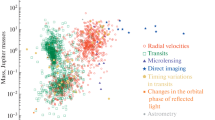Abstract
We investigate 1D exoplanetary distributions using a novel analysis algorithm based on the continuous wavelet transform. The analysis pipeline includes an estimation of the wavelet transform of the probability density function (p.d.f.) without pre-binning, use of optimized wavelets, a rigorous significance testing of the patterns revealed in the p.d.f., and an optimized minimum-noise reconstruction of the p.d.f. via matching pursuit iterations.
In the distribution of orbital periods, \(P\), our analysis revealed a narrow subfamily of exoplanets within the broad family of “warm Jupiters”, or massive giants with \(P\gtrsim 300~\mbox{d}\), which are often deemed to be related with the iceline accumulation in a protoplanetary disk. We detected a p.d.f. pattern that represents an upturn followed by an overshooting peak spanning \(P\sim 300\mbox{--}600~\mbox{d}\), right beyond the “period valley”. It is separated from the other planets by p.d.f. concavities from both sides. It has at least 2-sigma significance.
In the distribution of planet radii, \(R\), and using the California Kepler Survey sample properly cleaned, we confirm the hints of a bimodality with two peaks about \(R=1.3R_{\oplus }\) and \(R=2.4R_{ \oplus }\), and the “evaporation valley” between them. However, we obtain just a modest significance for this pattern, 2-sigma only at the best. Besides, our follow-up application of the Hartigan and Hartigan dip test for unimodality returns 3 per cent false alarm probability (merely 2.2-sigma significance), contrary to 0.14 per cent (or 3.2-sigma), as claimed by Fulton et al. (2017).
















Similar content being viewed by others
Notes
Since we analyze the distribution of \(\log P\) actually, \(a\) has the meaning of a relative scale. That is, \(a=0.3\) infers about \(\pm 15\) per cent range from a given \(P\).
Note that details in the \(A\)-distribution should be always blurred additionally, because \(M_{\star }\) often involves remarkable uncertainties. But this effect is smaller than the scatter of \(M_{\star }\) in the sample.
We used a public python implementation of the test, available at https://github.com/alimuldal/diptest.
References
Baluev, R.V.: Mon. Not. R. Astron. Soc. 385, 1279 (2008)
Baluev, R.V.: Mon. Not. R. Astron. Soc. 436, 807 (2013)
Baluev, R.V.: Astron. Comput. 23, 151 (2018)
Cumming, A.: In: Seager, S. (ed.) Exoplanets, p. 191. University of Arizona Press, Tucson (2010). Chapter 9
Foster, G.: Astron. J. 109, 1889 (1995)
Foster, G.: Astron. J. 111, 541 (1996)
Freedman, D., Diaconis, P.: Z. Wahrscheinlichkeitstheor. Verw. Geb. 57, 453 (1981)
Fulton, B.J., Petigura, E.A., Howard, A.W., Isaacson, H., Marcy, G.W., Cargile, P.A., Hebb, L., Weiss, L.M., Johnson, J.A., Morton, T.D., Sinukoff, E., Crossfield, I.J.M., Hirsch, L.A.: Astron. J. 154, 109 (2017)
Gelman, A., Loken, E.: Am. Sci. 102, 460 (2014)
Hara, N.C., Boué, G., Laskar, J., Correia, A.C.M.: Mon. Not. R. Astron. Soc. 464, 1220 (2017)
Hartigan, J.A., Hartigan, P.M.: Ann. Stat. 13, 70 (1985)
Hasegawa, Y., Pudritz, R.E.: Astrophys. J. 778, 78 (2013)
Hayashi, C.: Prog. Theor. Phys. Suppl. 70, 35 (1981)
Ida, S., Lin, D.N.C.: Astrophys. J. 604, 388 (2004)
Ida, S., Lin, D.N.C.: Astrophys. J. 685, 584 (2008)
Johnson, J.A., Petigura, E.A., Fulton, B.J., Marcy, G.W., Howard, A.W., Isaacson, H., Hebb, L., Cargile, P.A., Morton, T.D., Weiss, L.M., Winn, J.N., Rogers, L.A., Sinukoff, E., Hirsch, L.A.: Astron. J. 154, 108 (2017)
Mayor, M., Queloz, D.: Nature 378, 355 (1995)
Owen, J.E., Wu, Y.: Astrophys. J. 847, 29 (2017)
Petigura, E.A., Howard, A.W., Marcy, G.W., Johnson, J.A., Isaacson, H., Cargile, P.A., Hebb, L., Fulton, B.J., Weiss, L.M., Morton, T.D., Winn, J.N., Rogers, L.A., Sinukoff, E., Hirsch, L.A., Crossfield, I.J.M.: Astron. J. 154, 107 (2017)
Roberts, D.H., Lehar, J., Dreher, J.W.: Astron. J. 93, 968 (1987)
Roques, F., Schneider, J.: The Extrasolar Planets Encyclopaedia (1995). www.exoplanet.eu
Schlaufman, K.C., Lin, D.N.C., Ida, S.: Astrophys. J. 691, 1322 (2009)
Schneider, J., Dedieu, C., Sidaner, P.L., Savalle, R., Zolotukhin, I.: Astron. Astrophys. 532, 79 (2011)
Schwarzenberg-Czerny, A.: Balt. Astron. 7, 43 (1998)
Skuljan, J., Hearnshaw, J.B., Cottrell, P.L.: Mon. Not. R. Astron. Soc. 308, 731 (1999)
Süveges, M.: Mon. Not. R. Astron. Soc. 440, 2099 (2014)
Acknowledgements
V.Sh. Shaidulin was supported by the Russian Foundation for Basic Research grant 17-02-00542 A. R.V. Baluev was supported by the Presidium of Russian Academy of Sciences programme P-28, subprogram “The space: investigating fundamental processes and their interrelations”. We thank the anonymous referee for their suggestions regarding this manuscript.
Author information
Authors and Affiliations
Corresponding author
Rights and permissions
About this article
Cite this article
Baluev, R.V., Shaidulin, V.S. Fine-resolution analysis of exoplanetary distributions by wavelets: hints of an overshooting iceline accumulation. Astrophys Space Sci 363, 192 (2018). https://doi.org/10.1007/s10509-018-3416-9
Received:
Accepted:
Published:
DOI: https://doi.org/10.1007/s10509-018-3416-9




